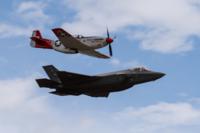One of the regular visitors to the Boise, Idaho, home is Maj. Gen. Michael Garshak, commander of the Idaho National Guard.
Not only does the general come bearing gifts -- most recently the shoulder patch from the Guard's 116th Cavalry Brigade Combat Team -- he also gives a morning brief to the veterans on the latest Guard news.
He also sits with the old-timers as they share stories about their time in service. They call it "Coffee WIth Vets."
Residents at the Idaho State Veterans Home, which can hold up to 150 men and women, are from all branches of service, including the Coast Guard. They also come from many different eras. Some remember the details of their time in service better than others.
In August 2019, photographer Thomas Alvarez began documenting those stories and capturing the faces of the veterans who told them. Here are some of their stories:
John 'Doc' Frayer, U.S. Navy, 1958-1965

Now 81, Frayer was a pre-med student at the University of Michigan when he was injured and lost his athletic scholarship. He decided to join the Navy as a corpsman. After two years on the blue side delivering babies, he went to the green side with a Marine Corps infantry unit based in Okinawa -- but destined for Vietnam.
While waiting to be airlifted to the jungle on their first patrol, "Doc" and his unit were attacked with grenades while still on the airfield. His first taste of combat came before he ever left the base.
Discharged after being wounded, Frayer stayed in the medical field as a civilian, where he spent the rest of his career.
John Mouw, U.S. Army, 1954-1957

Mouw escaped the local police of his hometown of Redmond, Washington, (he didn't say why they were after him) to enlist in the Army. According to him, the service's uniform was a lot more attractive than a prison jumpsuit.
He was pressured to be a military policeman, the irony of which was not lost on him.
Instead, he was sent to the Massachusetts Institute of Technology to learn to become a radio traffic analyst. He was quickly sent to South Korea for 16 months, analyzing communications and writing reports. Mouw spent the rest of his military career at Fort Meade, Maryland.
When he left, he attended Central Washington University on the G.I. Bill, expecting to become a lawyer. When Travelers Insurance Company made him and his wife a job offer in 1960, they moved to Idaho to take the job instead.
Leslie McCumber and Skip Nadeau, U.S. Air Force, 1967-1971

McCumber chose the Air Force because college "wasn't for me," she said. Nadeau joined for the educational opportunities.
She became a medic, serving stateside and at Clark Air Force Base in the Philippines. He became a B-52 Stratofortress crew chief who served in the skies over Vietnam.
They were in the Air Force during the same time period but didn't meet until a blind date nine years after they separated -- from the military, that is.
"I opened the door and immediately knew I was going to marry him," McCumber said.
They've been together ever since and married for 38 years.
Mike Powell, U.S. Coast Guard, 1971-1975

Not everyone who joins the Coast Guard is OK with the pitch and roll of ocean waves. Powell was one of them. He loved his time as a Coastie, but was initially seasick aboard his first assignment, the Cutter Winnebago. Never fear, he was soon coaching his fellow Coasties on how to embrace the motion of the ocean.
After leaving the Winnebago, Powell spent his time aiding in the navigation of ships and aircraft in Hawaii, and then patrolling the mouth of the Columbia River near Portland, Oregon, before leaving the Coast Guard and returning to his native Idaho.
Bill Hann, U.S. Army, 1944-1946

Hann was drafted into the Army to fight against the Axis Powers in Europe. At age 100, he has trouble recalling all the details from his time in the service, but he does remember he was wounded on the Western Front and that he recovered in about two months.
The Oklahoma native stayed in Europe until V-E Day and eventually went home to continue life as a farmer.
J.W. Young, U.S. Air Force, 1947-1969

An Ohio native, Young joined the newly minted Air Force after World War II, staying on active duty for 22 years. He spent his career as a crew chief with an aircrew and flew 104 missions during the Berlin Airlift.
One of his favorite stories is about his aircraft crew working for the CIA. They landed in Poland at a remote airfield, deep behind the Iron Curtain, to pick up CIA contacts. There, they picked up a man and a woman in a field who spoke no English. The entire operation took minutes. When they arrived in Germany, they discovered the couple weren't the CIA contacts they had been sent for, but rather just two people out for a walk.
Bart Weseloh, U.S. Navy, 1962-1966

Weseloh wishes he had stayed in the Navy. His role was aircraft ops and aviation support, and he was based in Alaska and California. After being forced to retire as a heavy equipment operator, his money soon ran out, and he had no living relatives.
"I decided to go up into the mountains and die," he said.
What he found when he climbed a mountain near Red Bluff, California, was a homeless camp. He spent time there, but it was not easy. He once went 17 days without food. Finally, he traded his truck to another resident and bought a bus ticket to Boise. He's been living at the Idaho State Veterans Home for 11 years.
"This place saved my life," Weseloh says.
He appreciates his home, helping clean and maintain the grounds and wash the facility's vehicles.
James Coy, U.S. Marine Corps, 1948-1952

Coy, now 89, joined the Marine Corps Reserve at age 18 in 1948 to avoid being drafted into the Army. Then an artilleryman, he was called to active duty when the Korean War broke out in 1950. Instead of manning his gun, he was handed a rifle and shipped to the front.
Every Marine is a rifleman, after all.
He was one of the Marines who found themselves surrounded and outnumbered 10-to-1 while in minus-36 degree snows near a place called the Chosin Reservoir. He was hit in the chest by a Chinese bullet and left to die, but the bullet was deflected by the bandoliers on his chest.
The lucky devil dog caught up to his retreating unit and, as he jumped into a ditch with them, another bullet hit him in the head. That, too, ricocheted away.
He credits his mother's prayers with saving his life.
-- Blake Stilwell can be reached at blake.stilwell@military.com.
Want to Learn More About Military Life?
Whether you're thinking of joining the military, looking for post-military careers or keeping up with military life and benefits, Military.com has you covered. Subscribe to Military.com to have military news, updates and resources delivered directly to your inbox.
















